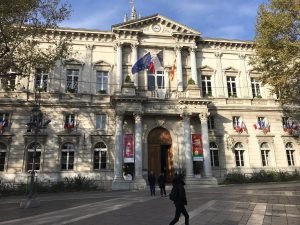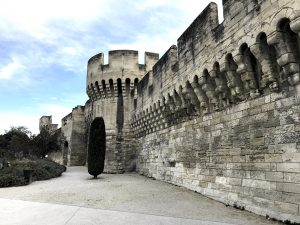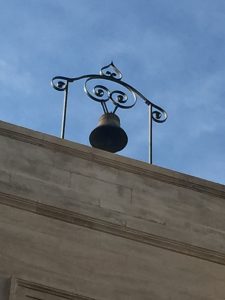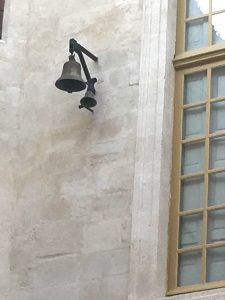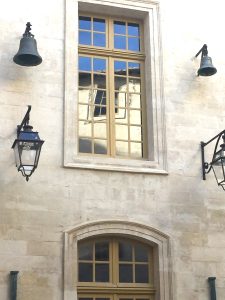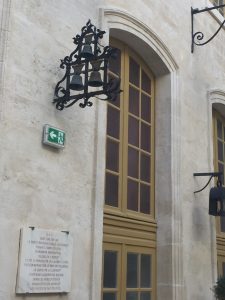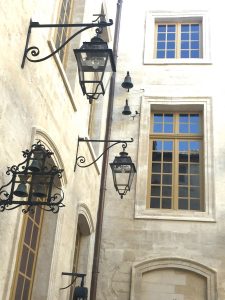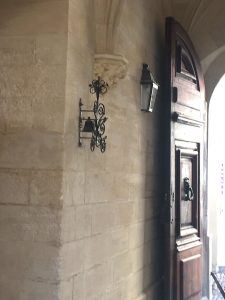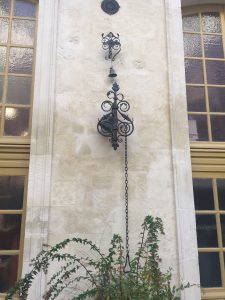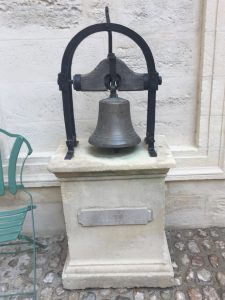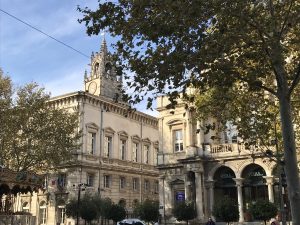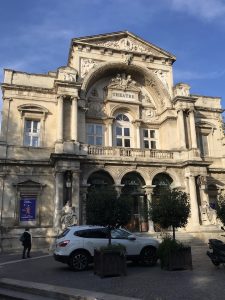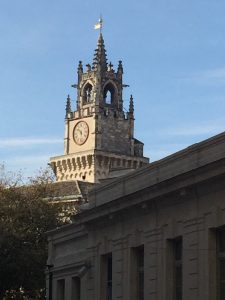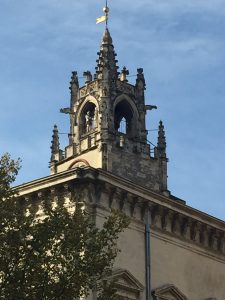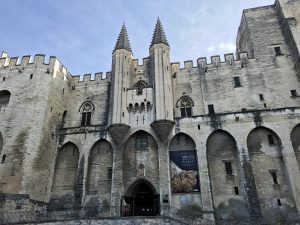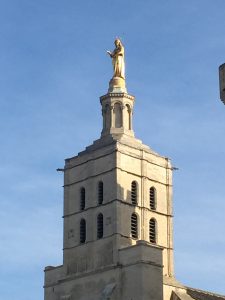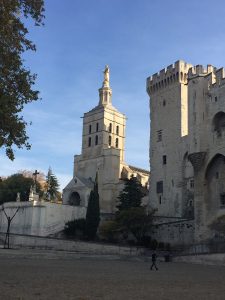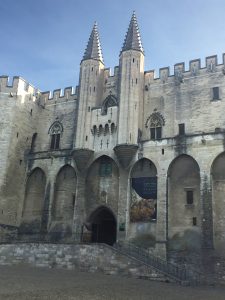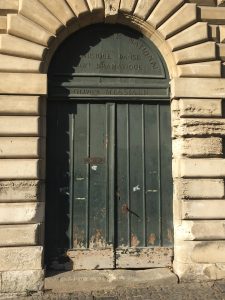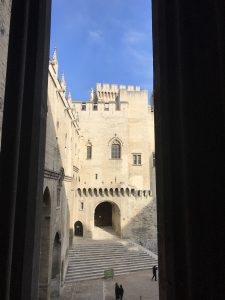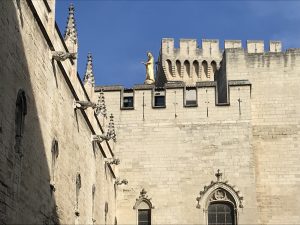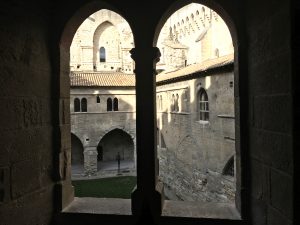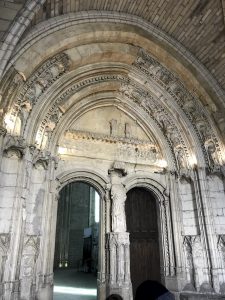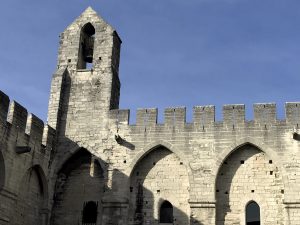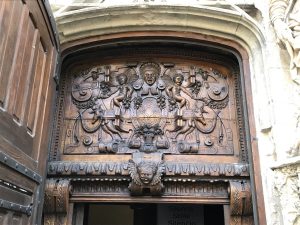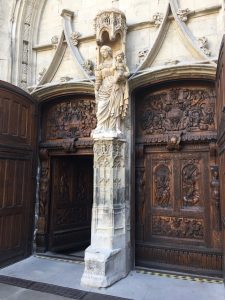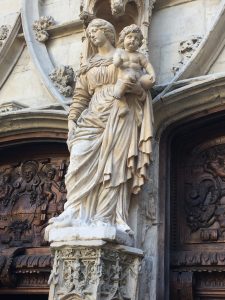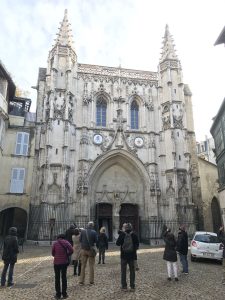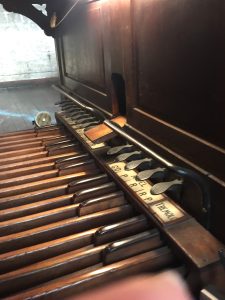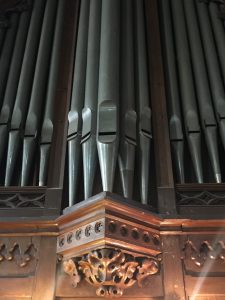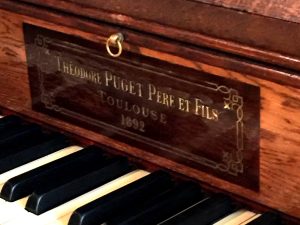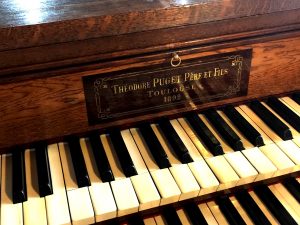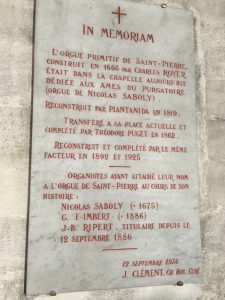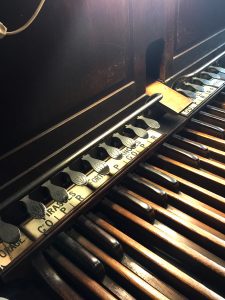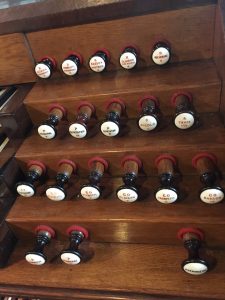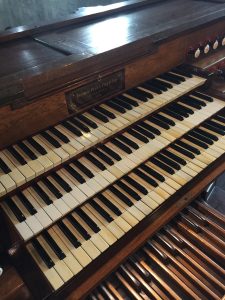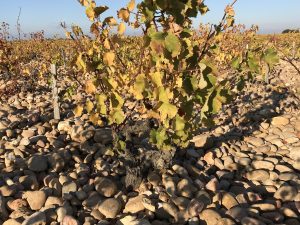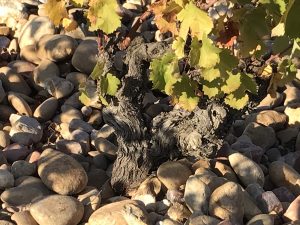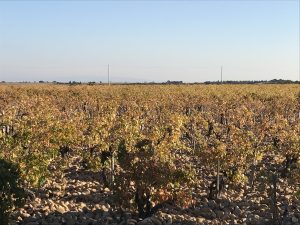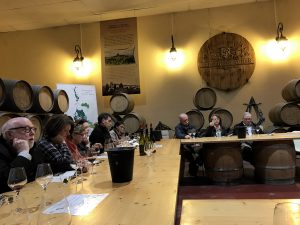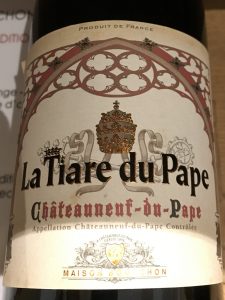Burgundy and Provence
Tuesday
Popes’ Palace and Châteauneuf du Pape
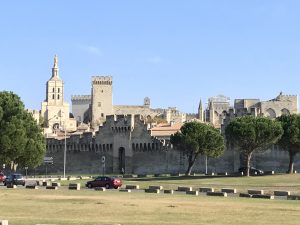 I woke up early, headed for the coffee bar, refreshed memories of yesterday and last night, then got excited all over again about the possibilities for the day. We were in Avignon, one of the great French cities of the fourteenth century, and we had signed up for an afternoon trip to wine tasting in Châteauneuf-du-Pape, one of my favorite wine appellations. What could be better?
I woke up early, headed for the coffee bar, refreshed memories of yesterday and last night, then got excited all over again about the possibilities for the day. We were in Avignon, one of the great French cities of the fourteenth century, and we had signed up for an afternoon trip to wine tasting in Châteauneuf-du-Pape, one of my favorite wine appellations. What could be better?
The ship had moved again overnight, so we were moored on the Rhône off the western side of the city. Avignon is one of those medieval cities where the walls are still complete, and it was fascinating to look out from the ship and see fortifications that had been there for hundreds of years.
Judy and I went with different groups again, and my group walked first through a small gate into the old city, along small streets and alleys, ending up for our first good look at Avignon on the Place de l’Horloge, Clock Square. This is the main commercial square of the old city, and today the Hôtel de Ville, theatres, and hotels and restaurants line it on all sides. If you stand in just the right place, you can actually spot the clock tower itself, though from most vantage points it’s obscured by the post-revolution buildings along the square. There are plane trees on both long sides that provide shade in summer, and if the wind weren’t still blowing, we would have seen restaurant tables and chairs almost everywhere. Given the low morning temperature (in the high 40s) and the incessant wind, that thought wasn’t very appealing and probably wouldn’t have been so by noon.
 We listened to Camille, our excellent guide, for a while, then walked on toward our next destination, the Palais des Papes. The Palace of the Popes is the most famous building of Avignon, with a crazy history spanning just about the entire 14th century. The facade, with those two crazy looking pointed towers beside the main entrance, is an image that I’ve had so long in my head I don’t remember when or where I first saw it. Probably in one of the French textbooks from Jr. High. No matter. I would recognize that anywhere, and for someone who pays much more attention to churches and their appearance than to noble houses, that’s saying a lot.
We listened to Camille, our excellent guide, for a while, then walked on toward our next destination, the Palais des Papes. The Palace of the Popes is the most famous building of Avignon, with a crazy history spanning just about the entire 14th century. The facade, with those two crazy looking pointed towers beside the main entrance, is an image that I’ve had so long in my head I don’t remember when or where I first saw it. Probably in one of the French textbooks from Jr. High. No matter. I would recognize that anywhere, and for someone who pays much more attention to churches and their appearance than to noble houses, that’s saying a lot.
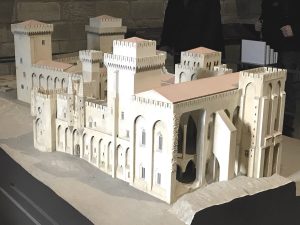 I would have enjoyed being able to go into the Cathedral again, but that wasn’t part of our visit. Instead, we toured the Palace, and that was a fun new experience for me. It’s huge, it’s empty, it’s historically important on a number of fronts, and I was completely taken with it. We walked through courtyards, we heard about the history of both the papacy and the building in the 14th century, and we enjoyed every minute of it. I don’t think I got as many good photos as I might have, but that might have been because I kept looking around instead of pointing my phone at things. I should do that more often! We did see the consistory/dining hall, several small chapels, and the grand chapel, and we passed through several extensive galleries and climbed a few steps. Who knew that the interior of the chapel had additional work done during the revolution, so that a three-story barracks filled that space? Somehow that part of history just passed me by. I was also not aware of just how widespread the damage to religious statuary had been during that period. I learned a lot during that tour!
I would have enjoyed being able to go into the Cathedral again, but that wasn’t part of our visit. Instead, we toured the Palace, and that was a fun new experience for me. It’s huge, it’s empty, it’s historically important on a number of fronts, and I was completely taken with it. We walked through courtyards, we heard about the history of both the papacy and the building in the 14th century, and we enjoyed every minute of it. I don’t think I got as many good photos as I might have, but that might have been because I kept looking around instead of pointing my phone at things. I should do that more often! We did see the consistory/dining hall, several small chapels, and the grand chapel, and we passed through several extensive galleries and climbed a few steps. Who knew that the interior of the chapel had additional work done during the revolution, so that a three-story barracks filled that space? Somehow that part of history just passed me by. I was also not aware of just how widespread the damage to religious statuary had been during that period. I learned a lot during that tour!
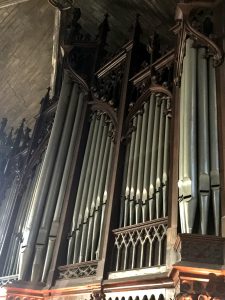 When we left the Palace we had two more stops to make. First we walked to another very small plaza in front of St. Pierre church. The facade was interesting enough, but the doors and the panels above them were striking. We went through the church, and I naturally looked up to the gallery to see the organ. It turned out to be a Puget, quite a respectable one, in fact, but I couldn’t see much from the floor. We rather quickly moved on through and out another door on the way to the market, but Judy had quite a different experience. She had gone with the Gentle Walking group, which didn’t go through the Palace. When her group got to St. Pierre, she asked about the organ, and her guide talked to the priest. Pretty soon the priest met them at the stairway with two large keys, and they went up to the organ gallery right away. All of Judy’s photos are wonderful, and you can check them out at the bottom of this page. There’s also a photo or two of the facade and the doorway, so don’t miss those.
When we left the Palace we had two more stops to make. First we walked to another very small plaza in front of St. Pierre church. The facade was interesting enough, but the doors and the panels above them were striking. We went through the church, and I naturally looked up to the gallery to see the organ. It turned out to be a Puget, quite a respectable one, in fact, but I couldn’t see much from the floor. We rather quickly moved on through and out another door on the way to the market, but Judy had quite a different experience. She had gone with the Gentle Walking group, which didn’t go through the Palace. When her group got to St. Pierre, she asked about the organ, and her guide talked to the priest. Pretty soon the priest met them at the stairway with two large keys, and they went up to the organ gallery right away. All of Judy’s photos are wonderful, and you can check them out at the bottom of this page. There’s also a photo or two of the facade and the doorway, so don’t miss those.
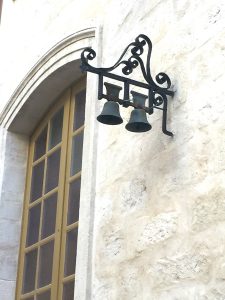 Judy’s group moved at a slower pace than mine did, so she had lots of time to stop and take photos of things she saw along the way. One of her favorite subjects is doors, and you’ll see a lot of those on all of these pages. Another thing she like to see is bells, and on this walk she saw a lot of them. I’m sure I walked past some of the same bells and doors, but my eye isn’t attuned to them like hers is. Some of these are fabulous photos, so be sure to check those out as well.
Judy’s group moved at a slower pace than mine did, so she had lots of time to stop and take photos of things she saw along the way. One of her favorite subjects is doors, and you’ll see a lot of those on all of these pages. Another thing she like to see is bells, and on this walk she saw a lot of them. I’m sure I walked past some of the same bells and doors, but my eye isn’t attuned to them like hers is. Some of these are fabulous photos, so be sure to check those out as well.
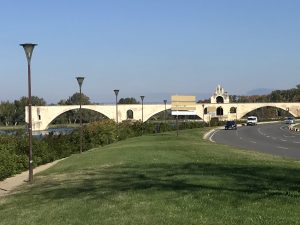 The visit to the covered market wasn’t the best part of the day so far as I was concerned, but I’ve been to a lot of those. I have to admit there are a few places I always check out in these situations: Pastry shops, butchers, and wine shops. Judy, however, is much better at using these opportunities to discover something of the local “flavor” by checking out things more carefully. We both understand places like this aren’t the usual shopping places for the locals; this is where they come if they want something really special. Maybe for a party or a holiday family meal. This day, with the Armistice Day holiday coming up at the end of the week, there were a lot of shoppers around.
The visit to the covered market wasn’t the best part of the day so far as I was concerned, but I’ve been to a lot of those. I have to admit there are a few places I always check out in these situations: Pastry shops, butchers, and wine shops. Judy, however, is much better at using these opportunities to discover something of the local “flavor” by checking out things more carefully. We both understand places like this aren’t the usual shopping places for the locals; this is where they come if they want something really special. Maybe for a party or a holiday family meal. This day, with the Armistice Day holiday coming up at the end of the week, there were a lot of shoppers around.
After our time in the market, we walked back to the ship for lunch. Judy and I compared notes on our mornings, and I took time to bundle up against the wind again and walk along the river. I could have walked back into the center of town to visit the cathedral, but decided not to go that far. I did manage to get a photo of “THE” bridge before the wind drove me back indoors. I made it back just in time for us to board the bus again for our afternoon excursion to Chàteauneuf-du-Pape for a wine tasting.
 We left Avignon by crossing a bridge (a newer one than “the” bridge) and driving north first through a number of upscale-looking neighborhoods. Soon the landscape changed, and we began to see the signs we were reaching our goal. Vineyards were appearing more and more frequently, and we rode through at least one other wine region (Lirac, I think) before we crossed back to the East bank and entered Chateauneuf-du-Pape vineyards. With all of our travels in Europe, Judy and I have seen a lot of vineyards, but most of those travels have been in the summer, or at least when vineyards were green. This time we were riding through vineyards after the harvest, when there were no grapes to be seen and leaves on the vines were the most spectacular shades of yellow, gold and red. Wow!
We left Avignon by crossing a bridge (a newer one than “the” bridge) and driving north first through a number of upscale-looking neighborhoods. Soon the landscape changed, and we began to see the signs we were reaching our goal. Vineyards were appearing more and more frequently, and we rode through at least one other wine region (Lirac, I think) before we crossed back to the East bank and entered Chateauneuf-du-Pape vineyards. With all of our travels in Europe, Judy and I have seen a lot of vineyards, but most of those travels have been in the summer, or at least when vineyards were green. This time we were riding through vineyards after the harvest, when there were no grapes to be seen and leaves on the vines were the most spectacular shades of yellow, gold and red. Wow!
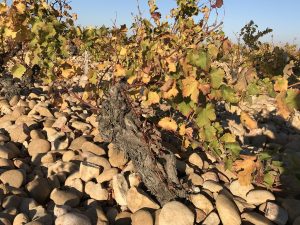 We reached the top of the plain that lies in the center of the Châteauneuf-du-Pape region when the sun was coming from low in the west, and even the wind couldn’t dampen my spirits. How much beauty can one take!? We had a quick stop for photos before continuing on to our “tasting,” and I enjoyed seeing a few things up close. First of all, we had been told that the vineyards had rocks from the Rhône around all of the vines, but they are much bigger than I expected. Many of them are the size of my fist and larger. The huge twisted trunks on the older vines were something else, and I would love to have a couple in bonsai pots. In fact I’d like to have a whole field of those old vines in my back yard, but I’d settle for a couple in pots. The trunk of the vine is this photo is about the size of my lower leg, both in girth and in length.
We reached the top of the plain that lies in the center of the Châteauneuf-du-Pape region when the sun was coming from low in the west, and even the wind couldn’t dampen my spirits. How much beauty can one take!? We had a quick stop for photos before continuing on to our “tasting,” and I enjoyed seeing a few things up close. First of all, we had been told that the vineyards had rocks from the Rhône around all of the vines, but they are much bigger than I expected. Many of them are the size of my fist and larger. The huge twisted trunks on the older vines were something else, and I would love to have a couple in bonsai pots. In fact I’d like to have a whole field of those old vines in my back yard, but I’d settle for a couple in pots. The trunk of the vine is this photo is about the size of my lower leg, both in girth and in length.
We then drove on to the shop of Maison Bouachon, where all of us who chose this optional excursion (about 20 people) took our seats around a table with each place set with three wine glasses and assorted nibbles. This tasting session was really well done, and we enjoyed the whole thing while we learned something about Châteauneuf-du-Pape wines in general and about Maison Bouachon wines in particular. It’s a shame we didn’t have bigger suitcases! I had no idea there was white Châteauneuf-du-Pape wine out there, and now I know why. Very little is produced each year, and this house, at least, never exports any. I guess I’ll just have to remember the taste. C’est la vie.
Where did they go? What did they see?
Arles and Les Baux de Provence

